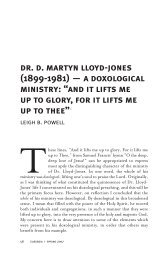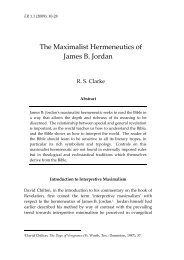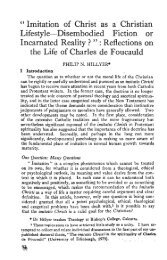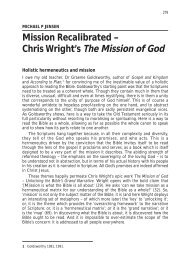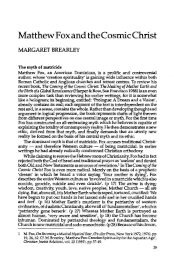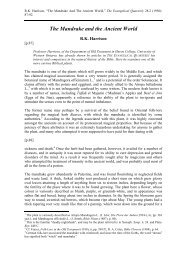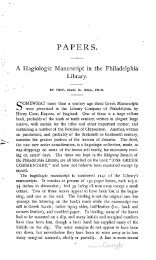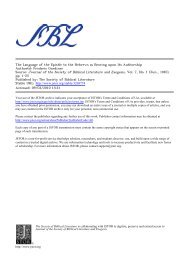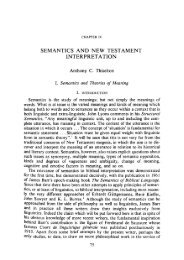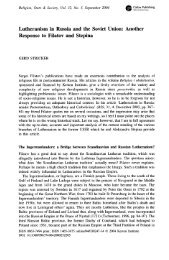Ancient Orient and Old Testament - BiblicalStudies.org.uk
Ancient Orient and Old Testament - BiblicalStudies.org.uk
Ancient Orient and Old Testament - BiblicalStudies.org.uk
Create successful ePaper yourself
Turn your PDF publications into a flip-book with our unique Google optimized e-Paper software.
K.A. Kitchen, <strong>Ancient</strong> <strong>Orient</strong> <strong>and</strong> <strong>Old</strong> <strong>Testament</strong>. London: Inter-Varsity Press, 1966. Hbk. pp.191.<br />
Babylonia. 61 Here, an Egyptian example will be instructive as a parallel problem. For the five<br />
Dynasties Thirteen to Seventeen (the socalled Second Intermediate Period in Egyptian history), the<br />
Turin Papyrus of Kings 62 records - or did when it was com-<br />
[p.74]<br />
plete - some 170 kings who reigned at least 520 years altogether. Now we also know that they all<br />
belong inside the period 1786 to c. 1550 BC, 63 a maximum period of only about 240 years at most -<br />
a hopeless contradiction? No. We know, too, that these dynasties were all partly contemporary: the<br />
520 or so years are genuine enough, but were partly concurrent, not all consecutive. This may prove<br />
equally true of some of the judges in early Israel, so that the 553-plus-x years would then fit into the<br />
roughly 300 years, just like the 520 or so into the roughly 240 in Egypt. Now in the <strong>Ancient</strong> <strong>Orient</strong>,<br />
chroniclers <strong>and</strong> other writers often used excerpts from fuller records, <strong>and</strong> this might explain the 480<br />
years - a total of selected figures (details now unknown) taken from the larger total. The various<br />
figures are therefore not so refractory in principle, when relevant principles are applied. To work this<br />
out in practice within the book of judges is not easy, simply because we need more detailed information<br />
on the period than is available there or from elsewhere. But neither is it beyond possibility (as<br />
is evident from an unpublished preliminary study). The problem of the book of judges is<br />
chronologically rather less complicated than other celebrated problems of Near Eastern chronology -<br />
such as the Second Intermediate Period in Egypt, or the date of Hammurapi of Babylon, where a<br />
similar situation obtains.<br />
Finally, in Judges 11:26, Jephthah (c. 1100 BC ??) speaks of Israel occupying Transjordan for 300<br />
years before his time, i.e., back to about 1400 BC if this is treated literally on modern reckoning,<br />
which does not fit a conquest at somewhere near 1240/1220 BC. But here again, we do not know the<br />
basis of Jephthah’s figure - it could, again, be an aggregate of partly concurrent periods (e.g., for<br />
Reuben, Gad <strong>and</strong> East Manasseh?), but we have no indications on which to build. Mesopotamian<br />
[p.75]<br />
61 Cf. H. Winekler, Altorientalische Forschungen, I, 1893, pp. 297 ff.; F. Delitzsch, Die Babylonische<br />
Chronik, 1906, pp. 43 ff. ‘Babylonian Chronicle’ is given complete in R. W. Rogers, Cuneiform Parallels to<br />
the <strong>Old</strong> <strong>Testament</strong> 2 , 1926, pp. 208-219; large extracts in English, also in ANET, pp. 301-307, plus D. J.<br />
Wiseman, Chronicles of Chaldaean Kings, 1956, <strong>and</strong> A. R. Millard, Iraq 26 (1964), pp. 14-35. The so-called<br />
‘Synchronous History’ par excellence may just possibly be the preamble to a treaty (Oppenheim, <strong>Ancient</strong><br />
Mesopotamia, 1964, p. 146, 284); W. G. Lambert regards this as a propag<strong>and</strong>a-text, not a treaty-preamble,<br />
Bibliotheca <strong>Orient</strong>alis 21 (1964), p. 182 end. No full translation is available, but snippets are given in P. van<br />
der Meer, The Chronology of <strong>Ancient</strong> Western Asia <strong>and</strong> Egypt 2 , 1955, <strong>and</strong> H. Tadmor, JNES 17 (1958), p.<br />
131 (further chronicle, ibid., p. 134).<br />
62 Text, Sir A. H. Gardiner, The Royal Canon of Turin, 1959; contents excerpted in Gardiner, Egypt of the<br />
Pharaohs, 1961, pp. 429-443 (Dyns. 13-17, pp. 440-443). On Egyptian lists, cf. also W. Helck,<br />
Untersuchungen zu Manetho <strong>and</strong> den altägyptischen Königslisten, 1956.<br />
63 For 1786 (end of Twelfth Dynasty), see R. A. Parker, The Calendars of <strong>Ancient</strong> Egypt, 1950, Excursus C; for<br />
about 1550 BC for start of the Eighteenth Dynasty, see E. Hornung, Untersuchungen zur Chronologie <strong>and</strong><br />
Geschichte des Neuen Reiches, 1964, pp. 15-23, 108, <strong>and</strong> my review in Chronique d’ Égypte 4o/Fasc. 8o (1965),<br />
pp. 310 - 322, esp. 311.




